Related Research Articles
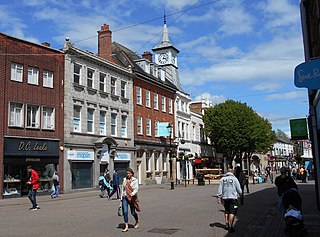
Nuneaton is a market town in the borough of Nuneaton and Bedworth in northern Warwickshire, England, located adjacent to the county border with Leicestershire to the north-east. Nuneaton's population at the 2021 census was 94,634, an increase from 86,552 at the 2011 census making it the largest town in Warwickshire.

Southam is a market town and civil parish in the Stratford-on-Avon district of Warwickshire, England. Southam is situated on the River Stowe, which flows from Napton-on-the-Hill and joins Warwickshire's River Itchen at Stoneythorpe, just outside the town.

Warwickshire is a ceremonial county in the West Midlands of England. It borders Staffordshire and Leicestershire to the north, Northamptonshire to the east, Oxfordshire and Gloucestershire to the south, and Worcestershire and the West Midlands county to the west. The largest settlement is Nuneaton.

Eaton Bray is a village and civil parish in Bedfordshire, England. It is situated about three miles south-west of the town of Dunstable and is part of a semi-rural area which extends into the parish of Edlesborough. In the 2011 United Kingdom census the population of the parish was recorded as 2,585.

Bulkington is a large village and former civil parish, now in the unparished area of Bedworth, in the Nuneaton and Bedworth district of Warwickshire, England. In the 2011 census the ward had a population of 6,146 and 6,303 in the 2001 census. It is located around 6 miles (10 km) northeast of Coventry, just east of the towns of Nuneaton and Bedworth and 5 miles (8 km) southwest of Hinckley. Despite historically having stronger links with Bedworth, Bulkington forms part of the Nuneaton Urban Area. Bulkington was mentioned in the Domesday Book as Bochintone, meaning "estate associated with a man called Bulca".

Meriden is a village and civil parish in the Metropolitan Borough of Solihull, West Midlands, England. Historically, it is part of Warwickshire and lies between the cities of Birmingham and Coventry. It is located close to the North Warwickshire district border within a green belt of the countryside known as the Meriden Gap and is in the ecclesiastical parish of the Diocese of Coventry.

Monks Kirby is a village and civil parish in north-eastern Warwickshire, England. The population of the parish is 445. Monks Kirby is located around one mile east of the Fosse Way, around 8 miles north-west of Rugby, seven miles north-east of Coventry and six miles west of Lutterworth. Administratively it forms part of the borough of Rugby. One of the largest and most important villages in this part of Warwickshire in the Anglo-Saxon and later medieval period, the village continued to be a local administrative centre into the early 20th century.
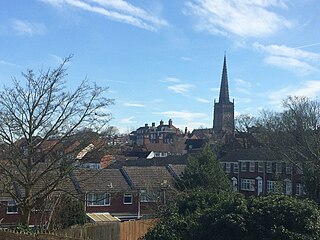
Coleshill is a market town and civil parish in the North Warwickshire district of Warwickshire, England, taking its name from the River Cole, on which it stands. It had a population of 6,897 in the 2021 Census, and is situated 10 miles (16 km) east-northeast of Birmingham, 9 miles (14 km) southeast of Sutton Coldfield, 11 miles (18 km) south of Tamworth, 13 miles (21 km) northwest of Coventry by road and 13 miles (21km) west of Nuneaton.
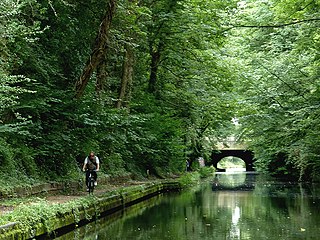
Olton is an area/suburban village within the Metropolitan Borough of Solihull in the West Midlands, England. In the 13th century, the Lords of the Manor moved their seat and formed a new settlement, at the junction of two major roads. It was then that Ulverlei was being referred to as ‘Oulton’ to distinguish itself from nearby Solihull. Historically within the county of Warwickshire, the village has gradually become contiguous with Solihull to the southeast, though it retains the character of a large independent village.

Great Coates is a village and civil parish in North East Lincolnshire, England. It is to the north-west and adjoins the Grimsby urban area, and is served by Great Coates railway station.
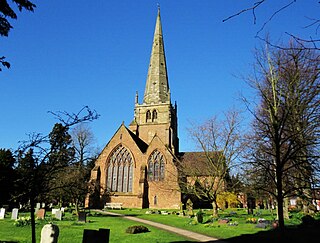
Solihull is a market town and the administrative centre of the Metropolitan Borough of Solihull in the West Midlands County, England. Solihull is situated on the River Blythe in the Forest of Arden area. The town had a population of 126,577 at the 2021 Census, and its wider borough had a population of 216,240 The town is located 8 miles southeast of Birmingham, 13 miles west of Coventry and 18 miles northwest of Warwick.
Ellistown is a village about 2 miles (3 km) south of Coalville in North West Leicestershire, England. It is named after Colonel Joseph Joel Ellis who died in 1885. The population from the 2011 census was included in the civil parish of Ellistown and Battleflat.
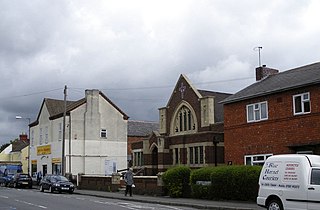
Attleborough is an area of Nuneaton, Warwickshire. It is about a mile south-east of the town centre.
St Nicolas Park is a suburban area of Nuneaton in Warwickshire, central England. It is a large housing estate, built between the 1960s and the 1990s. It is situated on the north-eastern edge of Nuneaton, close to the A5 and approximately 1½ miles from the town centre.

The River Sence is a river which flows in Leicestershire, England. The tributaries of the Sence, including the Saint and Tweed, fan out over much of western Leicestershire from Charnwood Forest and Coalville in the north-east to Hinckley and almost to Watling Street in the south and south-west. Its watershed almost coincides with Hinckley and Bosworth Borough of Leicestershire, which was formed in 1974 by amalgamation of Market Bosworth Rural District and Hinckley Urban District. It flows into the Anker, which in turn flows into the River Tame. It is part of the wider River Trent catchment, which covers much of central England. In 1881, Sebastian Evans wrote that the usual names for this river were Shenton Brook and Sibson Brook.
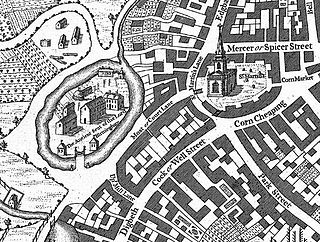
The Birmingham Manor House or Birmingham Moat was a moated building that formed the seat of the Lord of the Manor of Birmingham, England during the Middle Ages, remaining the property of the de Birmingham family until 1536. The buildings were demolished and the moat filled-in in 1815–16, but the remains of medieval stone structures excavated in 1973–75 survive intact beneath the buildings of the Birmingham Wholesale Markets.

Priory Park is an urban park located in the centre of Warwick, England. Originally the land was the grounds of a 12th-century priory dedicated to St Sepulchre and built in 1124 but this was closed down by King Henry VIII during the dissolution of the Monasteries. It was then destroyed and a residential home was built in 1566 by a man named Thomas Fisher known as Hawkins. In the 17th century, the estate was owned by Sir Thomas Puckering, 1st Baronet and his heirs, including Sir Henry Puckering, 3rd Baronet who was MP for Warwickshire and then the borough of Warwick.

Nuneaton Priory was a medieval Benedictine monastic house in Nuneaton, Warwickshire, England. It was founded as a daughter house of the Order of Fontevraud in 1153.

St. Nicolas Church is the parish church of Nuneaton, Warwickshire, England owned by the Church of England. The building dates back to around 1340 and is a Grade I listed building.
References
- 1 2 'Site of Horeston Grange, Nuneaton', Historic site listing at Our Warwickshire website (ourwarwickshire.org.uk, retrieved 31 August 2022).
- ↑ Historic England Research Records: Horeston Grange, Hob Uid 336215, (Heritage Gateway).
- ↑ See an anecdotal (unreferenced) account of the history of Horeston Grange (adapted from an article by Peter Lee for the "Nuneaton Civic Society" website) at the Weddington Castle website (retrieved 1 September 2022).
- ↑ W. Brown, 'Attleborough: Palaeolithic finds from Horeston Grange (SP 3780 9150)', West Midlands Archaeology 36 (1993), pp. 81-82.
- 1 2 3 "Horeston Grange", in W. Dugdale, ed. and revised by W. Thomas, The Antiquities of Warwickshire Illustrated, 2nd Edition, 2 vols (John Osborn and Thomas Longman, London 1730), II, p. 1070 (Google): repeated in S. Whatley, England's Gazetteer, 3 vols (J. and P. Knapton, etc., London 1751), I, p. 315 (Google).
- ↑ "Horeston Grange" (referenced), J. Nichols, History and Antiquities of Aston Flamvile and Burbach, including the hamlets of Sketchley and Smockington, and the Granges of Leicester and Horeston, in the Counties of Leicester and Warwick: with an Appendix to the History of Hinckley (J. Nichols, London 1787), p. 240: in Bibliotheca Topographica Britanniae, Vol. VII (J. Nichols, London 1790), p. 352 (Google).
- ↑ "Priorissa de Eton h'et... apud grangea' de Horeston in eodem dec' sex car' terre & val' car' p' annu' 0-10-00; et h'et ib'm de p'fic' stauri p' annu' 0-07-00", Taxatio ecclesiastica Angliae et Walliae auctoritate P. Nicholai IV. circa A. D. 1291 (Commissioners, 1802), p. 256 b (Münchener DigitalisierungsZentrum, Digitale Bibliothek/Bayerische StaatsBibliothek) (digitale-sammlungen.de).
- ↑ B.M. Kerr, "Religious life for women from the twelfth century to the middle of the fourteenth century with special reference to the English foundations of the Order of Fontevraud" (Ph.D. Dissertation), St Anne's College, University of Oxford (Trinity 1995), p. 214 (pdf p. 233) (ora.ox.ac.uk).
- 1 2 'Houses of Benedictine nuns: Priory of Nuneaton', in W. Page (ed.), A History of the County of Warwick, II (V.C.H., London 1908), pp. 66-70 (British History Online).
- ↑ For whom, see S.M. Thorpe, 'Constable, Sir Marmaduke II (by 1498-1560), of London and Nuneaton, Warws.', in S.T. Bindoff (ed.), The History of Parliament: the House of Commons 1509-1558 (from Boydell and Brewer, 1982), History of Parliament Online.
- ↑ 'Constable of Flamborough', in J. Foster (comp.), Pedigrees of the County Families of Yorkshire, 3 volumes (W. Wilfred Head for the author, London 1874), II (recte III): North and East Riding, unnumbered sheet in alphabetical sequence (Internet Archive).
- 1 2 'The Borough of Nuneaton: Horeston Grange', in L.F. Salzman (ed.), A History of the County of Warwick, IV: Hemlingford Hundred (V.C.H., London 1947), 165-73 (British History Online (accessed 31 August 2022).
- ↑ W.J.J., 'Hales, Stephen (d.1574), of Gladbury, Worcs., Tottenham, Mdx., Coventry and Exhall, Warws.', in P.W. Hasler (ed.), The History of Parliament: the House of Commons 1558-1603 (from Boydell and Brewer, 1981), History of Parliament Online, where they are called "Horeton Wood and fields".
- 1 2 "Horeston Grange Moat, Nuneaton", Warwick Museum Timetrail website, Record no. MWA 1691 (accessed 31 August 2022).
- 1 2 B. Gethin, (Observation of Warwickshire Museum trenches), Annual Report of the Medieval Settlement Research Group No. 9 (1994), p. 46.
- ↑ 'The Midland and the North British', The Railway News and Joint-Stock Journal, Vol. XIV, 19 November 1870, p. 605 (Google).
- ↑ 'Railway Extensions', The Engineer, Vol. XXX, 25 November 1870, p. 358 (Google).